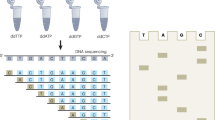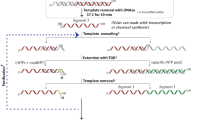Abstract
METHODS for sequencing nucleic acids have improved significantly in the last few years due to the development of rapid ‘read-off’ gel methods. The first method to be developed was the ‘plus and minus’ copying method for DNA1 and an analogous copying method for RNA now exists2. A different and more direct method for sequencing DNA has been developed3, but no direct method is available for RNA. We have developed such a method and here we describe its use in establishing the sequence of tyrosine tRNA of Bacillus stearothermophilus. This sequence is especially interesting as the tyrosine tRNA and its specific synthetase in B. stearothermophilus offer an attractive experimental system for studying the specific interaction of tRNA and synthetases, which is now possible because of progress in studying the three-dimensional structure of the protein by X-ray crystallography4.
This is a preview of subscription content, access via your institution
Access options
Subscribe to this journal
Receive 51 print issues and online access
$199.00 per year
only $3.90 per issue
Buy this article
- Purchase on Springer Link
- Instant access to full article PDF
Prices may be subject to local taxes which are calculated during checkout
Similar content being viewed by others
References
Sanger, F. & Coulson, A. R. J. molec. Biol. 94, 441–448 (1975).
Brownlee, G. G. & Cartwright, E. M. J. molec. Biol. 114, 93–117 (1977).
Maxam, A. M. & Gilbert, W. Proc. natn. Acad. Sci. U.S.A. 74, 560–564 (1977).
Irwin, M. J., Nyborg, J., Reid, B. R. & Blow, D. M. J. molec. Biol. 105, 577–586 (1976).
Brownlee, G. G. Laboratory Techniques in Biochemistry and Molecular Biology I 3 (North-Holland, Amsterdam, 1972).
Schmidt, M., Pipy, D., Wolny, M. & Bargetzi, J.-P. Experimentia 28, 739–740 (1972).
Pilly, D., Niemeyer, A., Schmidt, M. & Bargetzi, J.-P. J. biol. Chem. (in the press).
Nishimura, S. Prog. Nucl. Acid Res. molec. Biol. 12, 49–85 (1972).
Contreras, R. Ph.D. thesis, Univ. Ghent.(1974).
Uchida, T., Arima, T. & Egami, F. J. Biochem. (Tokyo) 67, 91–102 (1970).
Schmukler, M., Jewett, P. B. & Levy, C. C. J. biol. Chem. 250, 2206–2212 (1975).
Gupta, R. C. & Randerath, K. Nucleic Acids Res. 4, 1957–1978 (1977).
Contreras, R. & Fiers, W. Analyt. Biochem. 67, 319–326 (1975).
Sternbach, H., von d. Haar, F., Schlimme, E., Gaertner, E. & Cramer, F. Eur. J. Biochem. 22, 166–172 (1971).
Donis-Keller, H., Maxam, A. M. & Gilbert, W. Nucleic Acids Res. 4, 2527–2538 (1977).
Author information
Authors and Affiliations
Rights and permissions
About this article
Cite this article
SIMONCSITS, A., BROWNLEE, G., BROWN, R. et al. New rapid gel sequencing method for RNA. Nature 269, 833–836 (1977). https://doi.org/10.1038/269833a0
Received:
Accepted:
Issue Date:
DOI: https://doi.org/10.1038/269833a0
This article is cited by
-
Early days of tRNA research: Discovery, function, purification and sequence analysis
Journal of Biosciences (2006)
-
A telomeric sequence in the RNA of Tetrahymena telomerase required for telomere repeat synthesis
Nature (1989)
-
An in vivo recombinant RNA capable of autocatalytic synthesis by Qβ replicase
Nature (1988)
-
A 20S particle ubiquitous from yeast to human
Journal of Molecular Evolution (1987)
-
Structure and evolution of the small subunit ribosomal RNA gene of Crithidia fasciculata
Current Genetics (1986)
Comments
By submitting a comment you agree to abide by our Terms and Community Guidelines. If you find something abusive or that does not comply with our terms or guidelines please flag it as inappropriate.



